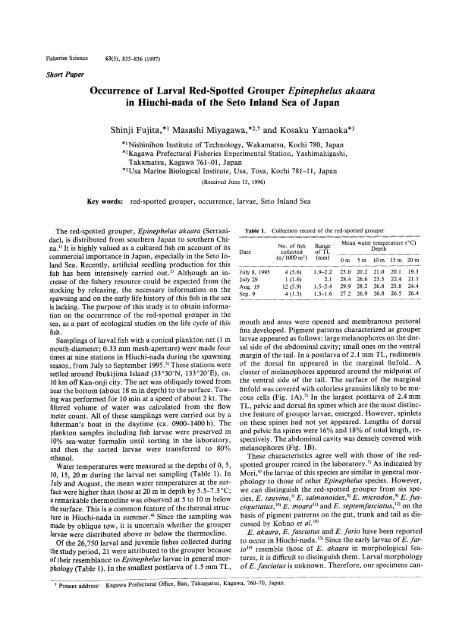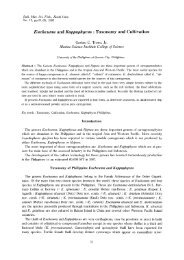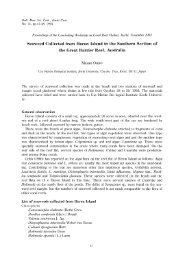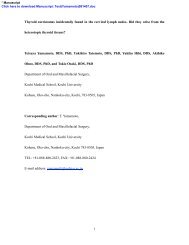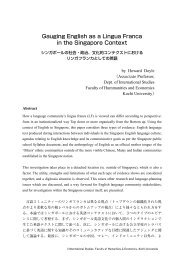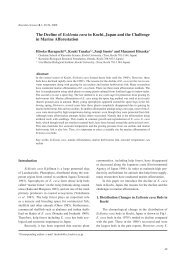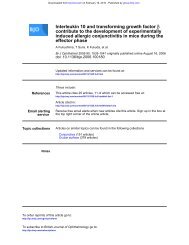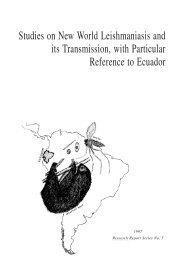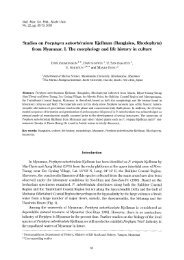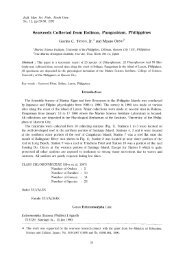Occurrence of Larval Red-Spotted Grouper Epinephelus akaara in ...
Occurrence of Larval Red-Spotted Grouper Epinephelus akaara in ...
Occurrence of Larval Red-Spotted Grouper Epinephelus akaara in ...
- No tags were found...
You also want an ePaper? Increase the reach of your titles
YUMPU automatically turns print PDFs into web optimized ePapers that Google loves.
Fisheries Science 63(5), 835-836 (1997)ShortPaper<strong>Occurrence</strong> <strong>of</strong> <strong>Larval</strong> <strong>Red</strong>-<strong>Spotted</strong> <strong>Grouper</strong> <strong>Ep<strong>in</strong>ephelus</strong> <strong>akaara</strong><strong>in</strong> Hiuchi-nada <strong>of</strong> the Seto Inland Sea <strong>of</strong> JapanSh<strong>in</strong>ji Fujita,*1 Masashi Miyagawa,*2,•õ and Kosaku Yamaoka*3*1Nish<strong>in</strong>ihon Institute <strong>of</strong> Technology, Wakamatsu, Kochi 780, Japan*2Kagawa Prefectural Fisheries Experimental Station, Yashimahigashi,Takamatsu, Kagawa 761-01, Japan*3Usa Mar<strong>in</strong>e Biological Institute, Usa, Tosa, Kochi 781-11, Japan(Received June 13, 1996)Key words: red-spotted grouper, occurrence, larvae, Seto Inland SeaThe red-spotted grouper, <strong>Ep<strong>in</strong>ephelus</strong> <strong>akaara</strong> (Serranidae), is distributed from southern Japan to southern Ch<strong>in</strong>a.1) It is highly valued as a cultured fish on account <strong>of</strong> itscommercial importance <strong>in</strong> Japan, especially <strong>in</strong> the Seto Inland Sea. Recently, artificial seedl<strong>in</strong>g production for thisfish has been <strong>in</strong>tensively carried out.2) Although an <strong>in</strong>crease <strong>of</strong> the fishery resource could be expected from thestock<strong>in</strong>g by releas<strong>in</strong>g, the necessary <strong>in</strong>formation on thespawn<strong>in</strong>g and on the early life history <strong>of</strong> this fish <strong>in</strong> the seais lack<strong>in</strong>g. The purpose <strong>of</strong> this study is to obta<strong>in</strong> <strong>in</strong>formation on the occurrence <strong>of</strong> the red-spotted grouper <strong>in</strong> thesea, as a part <strong>of</strong> ecological studies on the life cycle <strong>of</strong> thisfish.Sampl<strong>in</strong>gs <strong>of</strong> larval fish with a conical plankton net (1 mmouth-diameter; 0.33 mm mesh-aperture) were made fourtimes at n<strong>in</strong>e stations <strong>in</strong> Hiuchi-nada dur<strong>in</strong>g the spawn<strong>in</strong>gseason, from July to September 1995.3) These stations weresettled around Ibukijima Island (33?30•ŒN, 133?20•ŒE), ca.10 km <strong>of</strong>f Kan-onji city. The net was obliquely towed fromnear the bottom (about 18 m <strong>in</strong> depth) to the surface. Tow<strong>in</strong>g was performed for 10 m<strong>in</strong> at a speed <strong>of</strong> about 2 kt. Thefiltered volume <strong>of</strong> water was calculated from the flowmeter count. All <strong>of</strong> these sampl<strong>in</strong>gs were carried out by afisherman's boat <strong>in</strong> the daytime (ca. 0900-1400 h). Theplankton samples <strong>in</strong>clud<strong>in</strong>g fish larvae were preserved <strong>in</strong>10% sea-water formal<strong>in</strong> until sort<strong>in</strong>g <strong>in</strong> the laboratory,and then the sorted larvae were transferred to 80%ethanol.Water temperatures were measured at the depths <strong>of</strong> 0, 5,10, 15, 20 m dur<strong>in</strong>g the larval net sampl<strong>in</strong>g (Table 1). InJuly and August, the mean water temperatures at the surface were higher than those at 20 m <strong>in</strong> depth by 5.5-7.3•Ž;a remarkable thermocl<strong>in</strong>e was observed at 5 to 10 m belowthe surface. This is a common feature <strong>of</strong> the thermal structure <strong>in</strong> Hiuchi-nada <strong>in</strong> summer.4) S<strong>in</strong>ce the sampl<strong>in</strong>g wasmade by oblique tow, it is uncerta<strong>in</strong> whether the grouperlarvae were distributed above or below the thermocl<strong>in</strong>e.Of the 26,750 larval and juvenile fishes collected dur<strong>in</strong>gthe study period, 21 were attributed to the grouper because<strong>of</strong> their resemblance to <strong>Ep<strong>in</strong>ephelus</strong> larvae <strong>in</strong> general morphology (Table 1). In the smallest postlarva <strong>of</strong> 1.5 mm TL,Table 1. Collection record <strong>of</strong> the red-spotted groupermouth and anus were opened and membranous pectoralf<strong>in</strong>s developed. Pigment patterns characterized as grouperlarvae appeared as follows: large melanophores on the dorsal side <strong>of</strong> the abdom<strong>in</strong>al cavity; small ones on the ventralmarg<strong>in</strong> <strong>of</strong> the tail. In a postlarva <strong>of</strong> 2.1 mm TL, rudiments<strong>of</strong> the dorsal f<strong>in</strong> appeared <strong>in</strong> the marg<strong>in</strong>al f<strong>in</strong>fold. Acluster <strong>of</strong> melanophores appeared around the midpo<strong>in</strong>t <strong>of</strong>the ventral side <strong>of</strong> the tail. The surface <strong>of</strong> the marg<strong>in</strong>alf<strong>in</strong>fold was covered with colorless granules likely to be mucous cells (Fig. 1A).5) In the largest postlarva <strong>of</strong> 2.4 mmTL, pelvic and dorsal f<strong>in</strong> sp<strong>in</strong>es which are the most dist<strong>in</strong>ctive feature <strong>of</strong> grouper larvae, emerged. However, sp<strong>in</strong>letson these sp<strong>in</strong>es had not yet appeared. Lengths <strong>of</strong> dorsaland pelvic f<strong>in</strong> sp<strong>in</strong>es were 16% and 18% <strong>of</strong> total length, respectively. The abdom<strong>in</strong>al cavity was densely covered withmelanophores (Fig. 1B).These characteristics agree well with those <strong>of</strong> the redspotted grouper reared <strong>in</strong> the laboratory.3) As <strong>in</strong>dicated byMori,6) the larvae <strong>of</strong> this species are similar <strong>in</strong> general morphology to those <strong>of</strong> other <strong>Ep<strong>in</strong>ephelus</strong> species. However,we can dist<strong>in</strong>guish the red-spotted grouper from six species, E. tauv<strong>in</strong>a,7) E. salmonoides,8) E. microdon,9) E. fuscoguttatus,10) E. moara11) and E. septemfasciatus,12) on thebasis <strong>of</strong> pigment patterns on the gut, trunk and tail as discussed by Kohno et al.10)E. <strong>akaara</strong>, E. fasciatus and E. fario have been reportedto occur <strong>in</strong> Hiuchi-nada.13) S<strong>in</strong>ce the early larvae <strong>of</strong> E. fario14) resemble those <strong>of</strong> E. <strong>akaara</strong> <strong>in</strong> morphological features, it is difficult to dist<strong>in</strong>guish them. <strong>Larval</strong> morphology<strong>of</strong> E. fasciatus is unknown. Therefore, our specimens can-•õ Preent address: Kagawa Prefectural Office, Ban, Takamatsu, Kagawa, 760-70, Japan.
836 Fujita et al .be about 5 to 10 days after hatch<strong>in</strong>g.Th e Hiuchi-nada bas<strong>in</strong> is locates <strong>in</strong> the central part <strong>of</strong>the Seto Inland Sea that is l<strong>in</strong>ked to an eastern channel <strong>of</strong>Kii by the Bisan Strait and to a western channel <strong>of</strong> Bungoby the Kurushima Strait. The residual tidal current is veryweak <strong>in</strong> the eastern part <strong>of</strong> Hiuchi-nada,17) and exchange<strong>of</strong> water <strong>in</strong> this area is low.15) The oceanographic conditions and short time-span from spawn<strong>in</strong>g <strong>of</strong> collected larvae suggest that the red-spotted grouper may spawn <strong>in</strong>summer not far from Ibukijima Island, located <strong>in</strong> theeastern part <strong>of</strong> Hiuchi-nada.We thank Dr. I. K<strong>in</strong>oshita, Fisheries Research Station <strong>of</strong> Kyoto University, for his valuable advice. We are <strong>in</strong>debted to the staff <strong>of</strong> the IbukijimaFisheries Cooperative Association and Nish<strong>in</strong>ihon Institute <strong>of</strong> Technology, who helped us <strong>in</strong> many ways. We are also grateful to Mrs. SophieFukudome for her k<strong>in</strong>d revision <strong>of</strong> our English text.Fig. 1. Postlarvae <strong>of</strong> the red-spotted grouper collected from Hiuch<strong>in</strong>ada.A) 2.1 mm TL preflexion larva; B) 2.4 mm TL preflexion larva.not be identified as the red-spotted grouper only by means<strong>of</strong> morphological features. On the other hand, there is agreat difference <strong>in</strong> the biomass among these three species<strong>in</strong>habit<strong>in</strong>g Hiuchi-nada, A large amount <strong>of</strong> red-spottedgrouper is usually caught by commercial fish<strong>in</strong>g <strong>in</strong> Hiuch<strong>in</strong>ada, while the other two species are seldom caught.15) Inaba13) also reported that E. fasciatus and E. fario were rare<strong>in</strong> B<strong>in</strong>go-nada and Hiuchi-nada, <strong>in</strong>ner regions <strong>of</strong> the SetoInland Sea. Underwater observations conducted by usaround Ibukijima Island s<strong>in</strong>ce 1994 have revealed frequentoccurrence <strong>of</strong> E. <strong>akaara</strong>, but none <strong>of</strong> E. fasciatus and E.fario. These evidences suggest that almost all <strong>of</strong> the grouper larvae collected around Ibukijima Island can be attributed to E. <strong>akaara</strong>.Accord<strong>in</strong>g to Ukawa et al.,3) the artificially reared redspotted grouper reaches 2.20-2.25 mm TL with<strong>in</strong> 4.5 daysafter hatch<strong>in</strong>g, when the yolk and oil globule have beencompletely consumed. The anterior part <strong>of</strong> the dorsal f<strong>in</strong>base appears just beh<strong>in</strong>d the head <strong>in</strong> a 7-day larva <strong>of</strong> 3.83mm TL, and a 15-day larva <strong>of</strong> 4.05 mm TL has long dorsaland pelvic sp<strong>in</strong>es. Fukuhara and Fushimi16) also reportedthat the elongated sp<strong>in</strong>es persist dur<strong>in</strong>g most <strong>of</strong> the larvallife, from 3 to 19 mm TL, (about 7 to 40 days after hatch<strong>in</strong>g). The red-spotted grouper larvae collected <strong>in</strong> thepresent study ranged from 1.5 to 2.4 mm TL. Accord<strong>in</strong>gto the morphological development, they were estimated toReferences1) P. C. Heemstra and J. E. Randall: FAO Fish. Synop., 16, 1-382(1993).2) Y. Kayano: SUISANZOSHOKU, 43,269-272 (1995) (<strong>in</strong> Japanese) .3) M. Ukawa, M. Higuchi, and S. Mito: Japan J. Ichtyol., 13, 156161 (1966) (<strong>in</strong> Japanese).4) H. Takeoka, Y. Ohno, and N. Inahata: J. Oceanogr. Soc. Japan,47, 33-44 (1991).5) T. Kaji, K. Yamaoka, T. Isshiki, and T. Yamada: Bull. Mar. Sd.Fish. Kochi Univ., 15, 117-120 (1995).6) K. Mori: <strong>in</strong> "An atlas <strong>of</strong> the early stage fishes <strong>in</strong> Japan" (ed . by M.Okiyama), Tokai Univ. Press, Tokyo, 1988, pp. 413 (<strong>in</strong> Japanese).7) N. A. Hussa<strong>in</strong> and M. Higuchi: Aquaculture, 19, 339-350 (1980).8) S. Hamamoto, S. Manabe, A. Kasuga, and K. Nosaka: Tech. Rep.Farm. Fish., 15, 143-155 (1986) (<strong>in</strong> Japanese).9) T. Tawada: SUISANZOSHOKU, 37, 99-103 (1989) (<strong>in</strong> Japanese).10) H. Kohno, S. Diani, and A. Supriatna: Japan J. Ichthyol., 40, 307316(1993).11) S. Manabe and A. Kasuga: J. Japan Assoc. Zool. Gardens Aquariums, 30, 16-24 (1988) (<strong>in</strong> Japanese).12) C. Kitajima, M. Takaya, Y. Tsukashima, and T. Arakawa: JapanJ. Ichthyol., 38, 47-55 (1991) (<strong>in</strong> Japanese).13) A. Inaba: Fauna and flora <strong>of</strong> the Seto Inland Sea, second edition II,Mukaishima Mar. Biol. Stn., Hiroshima, 1988, pp. 475 (<strong>in</strong>Japanese).14) A. Tsujigadou and B. Hayashi: Bull. Mie Pref. Owase Fish. Exp.Stn., 29-34 (1982) (<strong>in</strong> Japanese).15) S. Hamamoto: Bull. Kagawa Pref. Fish. Exp. Stn., 2, 39-45 (1986)(<strong>in</strong> Japanese).16) O. Fukuhara and T. Fushimi: Aquaculture, 69, 379-386 (1988).17) T. Yanagi, H. Takeoka, and H. Tsukamoto: J. Oceanogr. Soc.Japan, 38, 293-299 (1982).18) T. Ochi and H. Takeoka: J. Oceanogr. Soc. Japan, 42, 1-11(1982).


